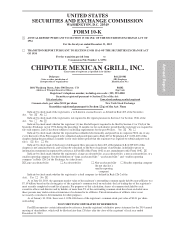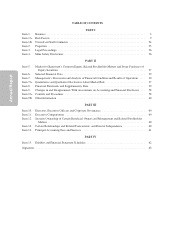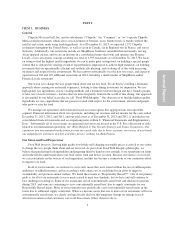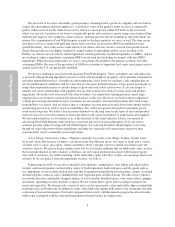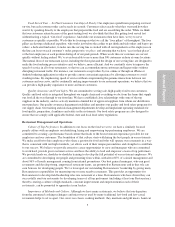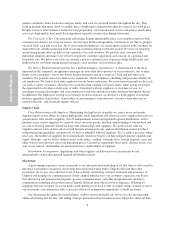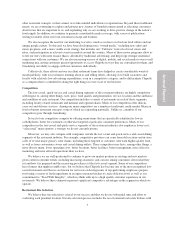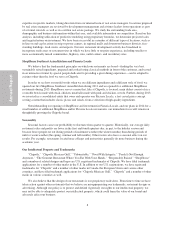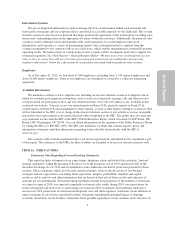Chipotle 2013 Annual Report Download - page 7
Download and view the complete annual report
Please find page 7 of the 2013 Chipotle annual report below. You can navigate through the pages in the report by either clicking on the pages listed below, or by using the keyword search tool below to find specific information within the annual report.
Food Served Fast … So That Customers Can Enjoy It Slowly. Our employees spend hours preparing our food
on-site, but each customer order can be ready in seconds. Customers select exactly what they want and how they
want it by speaking directly to the employees that prepared the food and are assembling the order. While we think
that our customers return because of the great-tasting food, we also think that they like getting food served fast
without having a typical “fast-food” experience. And while our restaurants often have lines, we try to serve
customers as quickly as possible. We do this by focusing on what we call the “four pillars” of throughput. The four
pillars are having a dedicated expeditor, who works just before the cashier to get drink and side orders and bag to-go
orders; a dedicated linebacker, to make sure the serving line is stocked with all our ingredients so the employees on
the line can focus on each customer’s order; proper mise en place; and ensuring that we have “aces in their places”,
or the best employees at each position during all of our peak periods. When we do this our customers are served
quickly without feeling rushed. We’ve even been able to serve more than 300 customers an hour at some locations.
The natural flow of our restaurant layout, including the floor plan and the design of our serving line, are designed to
make the food ordering process intuitive and, we believe, more efficient. And we constantly strive to improve the
speed of service in all of our restaurants, so that we can accommodate more customers and larger orders without
disrupting restaurant traffic. For instance, our restaurants accept orders by fax, online or through an iPhone or
Android ordering application in order to provide a more convenient experience by allowing customers to avoid
standing in line. By emphasizing speed of service without compromising the genuine interactions between our
customers and our crews, and by continually making improvements to our restaurant operations, we believe that we
can provide a high quality experience to more and more customers.
Quality Assurance and Food Safety. We are committed to serving safe, high quality food to our customers.
Quality and food safety is integrated throughout our supply chain and everything we do; from the farms that supply
our food all the way through to our front line. We have established close relationships with some of the top
suppliers in the industry, and we actively maintain a limited list of approved suppliers from whom our distributors
must purchase. Our quality assurance department establishes and monitors our quality and food safety programs for
our supply chain. Our training and risk management departments develop and implement operating standards for
food quality, preparation, cleanliness and safety in the restaurants. Our food safety programs are also designed to
ensure that we comply with applicable federal, state and local food safety regulations.
Restaurant Management and Operations
Culture of Top Performers. In addition to our focus on the food we serve, we have a similarly focused
people culture with an emphasis on identifying, hiring and empowering top performing employees. We are
committed to creating a performance based culture that leads to the best restaurant experience possible for our
employees and our customers. The foundation of that culture starts with hiring the best people in our restaurants.
We make an effort to hire employees who share a passion for food and who will operate our restaurants in a way
that is consistent with our high standards, yet allows each of their unique personalities and strengths to contribute
to our success. We believe we provide attractive career opportunities to crew and managers who are committed
to work hard, provide great customer service and have the ability to lead and empower a team of top performers.
We provide hands on, shoulder-to-shoulder training to develop the full potential of our restaurant employees. We
are committed to developing our people and promoting from within, with about 85% of salaried management and
about 96% of hourly management coming from internal promotions. Our best general managers, who run great
restaurants and develop strong, empowered restaurant teams, are promoted to Restaurateur and in that role can
earn bonuses for developing people. We’ve leveraged our outstanding Restaurateurs’ leadership by giving many
Restaurateurs responsibility for mentoring one or more nearby restaurants. This provides an opportunity for
Restaurateurs to develop field leadership roles one restaurant at a time. Restaurateurs who have shown they can
successfully run four restaurants by developing teams of all top performers (including at least one Restaurateur),
thereby creating a culture of high standards, constant improvement and empowerment in each of their
restaurants, can be promoted to apprentice team leaders.
Importance of Methods and Culture. Although we have many restaurants, we believe that our departure
from the automated cooking techniques and microwaves used by many traditional fast-food and fast-casual
restaurants helps to set us apart. Our crews use classic cooking methods: they marinate and grill meats, hand-cut
5
Annual Report



